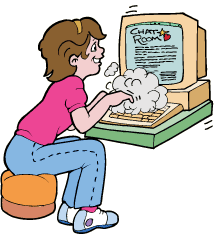Learning Online Tips: page 5
Use Good ‘Netiquette’

‘Netiquette’ is a combination of the words “network” and “etiquette”, and is an informal code of manners governing online conduct. Remember even though you are working in a digital environment, you are communicating with real people; please respect their attitudes and feelings just as you would in person. Choose your language appropriately. Your online course is like a virtual classroom; make sure your comments online are up to the same standards you would apply in a regular classroom setting. Learn more about communication netiquette at: Albion.com's Netiquette Online Edition
Here are the some good ‘netiquette’ rules to follow when communicating online:
- Avoid using Capital Letters
- Using all capital letters in your online writing is interpreted as SHOUTING
- Respect others and their opinions
- In online learning, students from various backgrounds come together to learn. It is important to respect their feelings and opinions though they may differ from yours in ideological, religious, or environmental perspectives.
- Consider others' privacy
- Ask for permission if you want to forward someone's email messages to third parties.
- Joking around
- Be careful when using humour. It is important to remember that tone of voice often plays an important role in letting people know that you are making a joke. Because people can't hear your voice they may think you are being sarcastic. Some people use slang such as LOL (laugh out loud) when joking online.
- Use emoticons
 Another way of making up for the lack of non-verbal cues is to insert emoticons into your writing. You can use them to express your feelings in online communication and to make ambiguous writing clearer. Emoticons like ‘smileys’ :) and ‘winks’ ;) let others know what you are thinking. Emoticons are an important part of online communication, but be careful not to overuse them. They work best if you use the most common ones that everyone understands. Learn more about emoticons at windweaver.com.
Another way of making up for the lack of non-verbal cues is to insert emoticons into your writing. You can use them to express your feelings in online communication and to make ambiguous writing clearer. Emoticons like ‘smileys’ :) and ‘winks’ ;) let others know what you are thinking. Emoticons are an important part of online communication, but be careful not to overuse them. They work best if you use the most common ones that everyone understands. Learn more about emoticons at windweaver.com.
- Don't Spam
 Spam is unsolicited “junk e-mail” sent to large numbers of people to promote products or services. It also refers to inappropriate promotional or commercial postings to discussion groups or bulletin boards. If you ‘spam’ your group by mistake, send out an immediate email apology.
Spam is unsolicited “junk e-mail” sent to large numbers of people to promote products or services. It also refers to inappropriate promotional or commercial postings to discussion groups or bulletin boards. If you ‘spam’ your group by mistake, send out an immediate email apology.- Joke Email
- Please be sure to ask before sending jokes, photos or other email to your classmates and be sure they have been scanned for viruses.
- Learn the names of your fellow learners
 A good way to familiarize yourself with the names of those in your class is to make a point of using the person's name when you are replying to them by email or in the Conversation Café. If you start your reply to someone with “Hi Josh” or “Hey, Susan” you will feel more like writing back to someone instead of writing to someone “out there in cyberspace”! Also remember that we all like to be acknowledged and addressed by our name.
A good way to familiarize yourself with the names of those in your class is to make a point of using the person's name when you are replying to them by email or in the Conversation Café. If you start your reply to someone with “Hi Josh” or “Hey, Susan” you will feel more like writing back to someone instead of writing to someone “out there in cyberspace”! Also remember that we all like to be acknowledged and addressed by our name.- Sign your Email
- Although email is often very informal in style, it is important to “sign” your email by including your name at the bottom of the email. Your fellow learners and instructors should not have to guess who sent them an Email.





